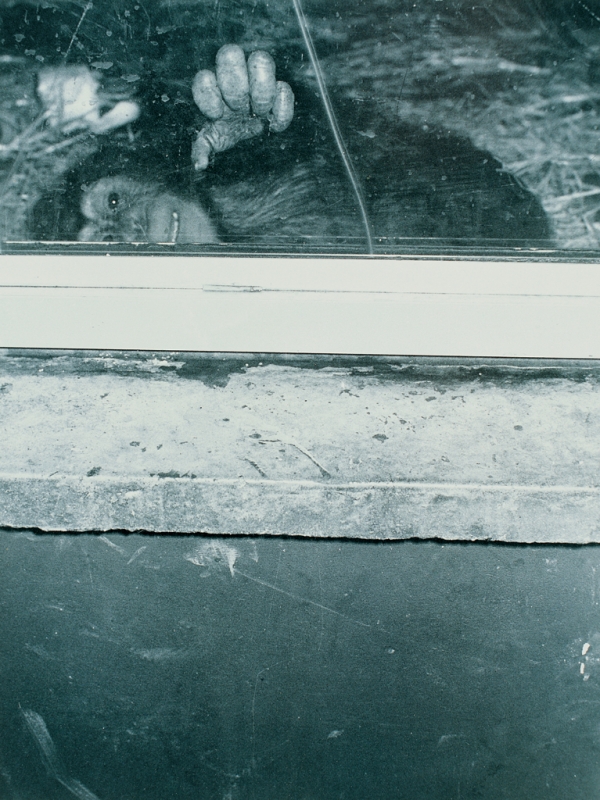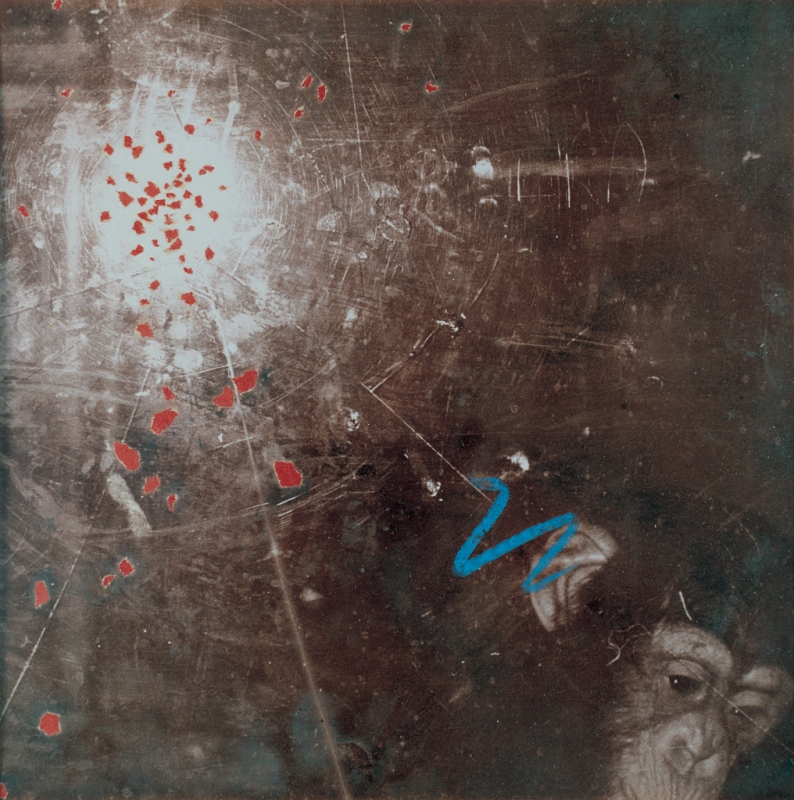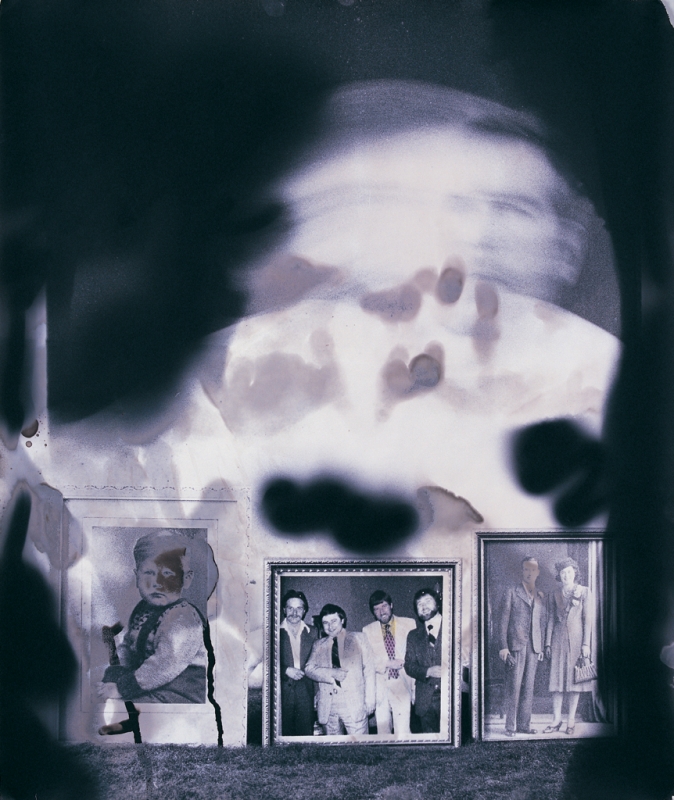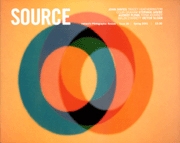Interfering with the Negative
An Interview with Victor Sloan
Issue 26 Spring 2001
View Contents ▸
View images from: Day of Action, Bangor ▸
A large retrospective of Victor Sloan's work was recently held at the Ormeau Baths Gallery in Belfast. Richard West interviewed the artist in the Source office and an edit of this interview is published here. The artist is best known for his series of marked images of Orange marches but he has also focused on other subjects such as his zoo pictures from 1983 and his photographs of Bangor from 1986. After discussing his experiences at art college and of teaching the conversation turned to his first photographic series:
VS: We've got to the early 80s. I think the start of the change was a series I took of Belfast zoo. I went along with the family - with the camera - as I always do, to take some family snaps. I was really appalled to see the conditions the monkeys were living in; behind glass, dirty and bored out of their skulls; really depressing stuff. So I took a lot of photographs of the monkeys. Some weeks later I developed the film and I just couldn't believe what was on it. For the first time ever what I had seen was there, I just couldn't believe it. I printed them up, I was quite happy with them in black and white and decided that they were good enough to be shown in an art gallery. I toned some of them and made a blue mark on one of them, because I happened to have a piece of blue crayon in my hand. Then I put a mark on another one. At that time the Octagon gallery asked me to put in some work and I submitted these. A show called the Best of Belfast. I think there might have been six hung in that show. Everybody liked them, they looked really bad! I say really bad, Best of Belfast was a sort of contradiction; I don't think anyone really called them that - that looked at them. People liked them as images. So that was the start.
RW: So we're in about 1980, had you taken any photographs before you took the series in the zoo?
VS: My mother was a great photographer, she was an amateur photographer but she loved cameras, she always bought the automatic, instant cameras; good amateur cameras with a built in flash and so on. Anyone who walked through the door she'd photogaph them. Having quite a lot of brothers and sisters and brothers and sisters on my father's side, an awful lot of cousins and aunts and uncles; people were always calling at the house and she photographed all of them. They are all in my attic now, I must wade through them some time. She really had a lot of photographs. So my mother would have been an influence and I would have taken family snaps as well. I took some photographs at the art college but they weren,t considered anything, the lecturers never looked at them or cared about them. I was there to paint and that was that. Belfast Zoo, Untitled, Silver Gelatin Print, 36.5cm x 27.5cm, 1983
Belfast Zoo, Untitled, Silver Gelatin Print, 36.5cm x 27.5cm, 1983
RW: So when did you start caring about photographs?
VS: I think probably when we lived in Dungannon, in Empire avenue. I remember getting chemicals, developer and fix. Then the negatives that came out of cameras were quite big and I remember doing contact prints from the negatives that the chemist had done. I remember going into the chemist and getting a box of photographic paper and the developer and fix, and going underneath the stairs in the house and doing contact prints just to see how it worked. That would have been while I was at school so that would have been my first contact with Photography!
RW: And do you know how you saw the connection between painting and the photographs that you were taking?
VS: There really wasn't any connection, the only connection would be that I might have used the photographs to paint from; to jog my memory or to use as a source for painting. But the photographs at the start were never photographs as art they were photographs as an aid to painting.
RW: Were you doing figurative painting?
VS: You name the fashion I went through it, at art college I went through the lot. I didn't settle on anything. I ended up with marks, I think I was taught 'marks' for painting, but I can't honestly remember what they were. They were good examples of that current trend.
RW: So when you started doing your own work again in Lurgan did you start by painting again or did you start directly into photography?
VS: I always kept up the painting and still do. I still think it's important that I know how to mix paint and how to paint and I still do that but I don't exhibit. Painting and photography started to run in parallel. In 1983 the photography won and became the art form, mainly because people accepted it as an art form and there was a reason to concentrate on it because they would show it. No point in doing something if nobody wants to see it.
RW: Where were you doing your work, did you have a studio at home?
VS: We lived in a few houses and in one of the houses there was a sort of boiler house and it was dark so I was able to do the processing in there. The house I'm in at present has a big attic and it's dark so I can do it in there. Belfast Zoo, Untitled, Silver Gelatin Print, Toner, Oil Pastel and Torn Paper, 25cm x 25cm, 1983
Belfast Zoo, Untitled, Silver Gelatin Print, Toner, Oil Pastel and Torn Paper, 25cm x 25cm, 1983
RW: Did you have a studio for painting in?
VS: Well, the kitchen, anywhere could become the studio. I didn't have a studio as such. When I'm working on something where I've got to paint, the kitchen, the kitchen table, any of the rooms in the house become my studio and the whole family tolerate it. They know that they are going to be walking over things for a few months until the exhibition's there. We have a conservatory at the front of the house and the light's brilliant, it's quite a big space, quite a good floor space. So the work would lie out there and I would paint on the floor. And there'd always be water in jars and paint sitting about. One day the milkman opened the door and sent the water and paint flying over one of them. I mopped it up and rescued it and it's OK. I quite rely on accidents like that.
RW: Did the milkman take some credit for it?
VS: He was really sorry that he'd done it. It was a show in Germany and I was able to show him the catalogue and he recognised the work he'd spilt all the paints over.
RW: Had you seen much other photographic work by this stage?
VS: I can't really think of anybody in Northern Ireland who was producing photographs at that time. The only other one, and I'm not sure when he appeared, would have been Willie Doherty. I'm not quite sure what date that would have been, but at some stage in the early 80s I would have become aware of Willie as another person who was using photography, but I can't think of anybody else.
RW: Had you seen work from the States or from the UK?
VS: Occasionally the Belfast museum would have got photographic exhibitions and Dublin would have got some and I would have seen some in London.
RW: In your particular way of working?
VS: No I was very much in a vacuum. Even at the minute I can't think of anyone who would do exactly what I do. No I was very much doing my own thing.
RW: So why did you first mark those photographs you had of the zoo?
VS: The blue mark went on because I had a blue oil crayon in my hand. I was probably doing work on a painting and made a mark on the photograph. It looked OK and I made a mark on another photograph. It certainly wasn't something I thought about. I didn't decide to combine painting techniques with photography it was something that just happened.
RW: So maybe your point of reference would had been some paintings that you were familiar with as much as photography?
VS: Yes maybe so, but I don't know what they would have been.
RW: Did you get any feedback from the show in the Octagon gallery?
VS: I think the reviews were quite good. Whatever was fed back to me was very positive and I knew they were good and to maybe continue in that way.
After the zoo pictures the artist continued to exhibit new series of work including pictures of Craigavon and taken from a moving car. In 1986 he photographed in Bangor:
VS: The Day of Action, Bangor series would be the next series of work and that was 1986 and it was a day of action, a protest against...
RW: ...the Anglo Irish agreement?
VS: There's been that many. The Anglo Irish agreement. This was the one tractors came out, lorries blocked roads, all hell broke loose, except in Bangor, where I happpened to be. I just couldn't believe how quiet it was. I heard the news bulletins. What I've done with those is to put a bit of violence into the seafront at Bangor. They are very quiet.
RW: They look almost like 19th century photographs.
VS: It's a funny thing, seasides never change; the same buildings, furniture, street furniture, summer seats, they are as they were.
RW: What time of year was this, during the summer?
VS: I don't remember when it was, but I think it was cold so yes probably was the summer. I don't remember.
RW: The marks you've put on these images are the most painterly perhaps of any of your work?
VS: That and Drumming, the work that deals with the marching season, in those works I've started to interfere with the negative; up until this stage any work was completed on the photographic print, water colours, paint, but in Day of Action, Drumming, Walk, The Platform and The Field, the orange march images, I've actually drawn onto the negative with ink or scraped it with a blade or a pin. I've combined work on the negative with the work on the photographic print. I've added to the techniques. Self-Portrait II, Silver Gelatin Print, with Coloured Pencils, 60cm x 50cm, 1993
Self-Portrait II, Silver Gelatin Print, with Coloured Pencils, 60cm x 50cm, 1993
RW: Had this happened by the time of these photographs in Bangor?
VS: Yes at this time I was working on the marching images at the same time.
RW: I was struck by those pictures; the very broad strokes of a brush. In some respect they are quite elegant as well. They are not as obviously aggressive as the later pictures.
VS: Yes you're right, because I didn't feel aggressive towards the print or the negative, or the subject, or the situation. Whereas in the marching images there is anger, frustration, violence, its all there. It's not only coming from me but it could be coming from another community towards this community, or from this community that I photographed to the other community. There is violence, frustration, annoyance all floating about from everybody.
RW: Are they more elegiac maybe?
VS: They could have well been from an archive I could have rephotographed that from any amount of work. They could be somebody else's photographs even.
RW: It's only the title that really gives the suggestion of events.
VS: They are completely timeless, as I think the marching season work is. That could have been 50 years ago, 30 years ago, 10 years ago, yesterday, last year. I mean I can only hope it isn't next year or the year after, or will it be? Is it the future?
Other articles by Richard West:
Source Photo: Do we need Photography Galleries? [Blog Post] ▸
Source Photo: The New Photo Galleries: A US Perspective [Blog Post] ▸
Source Photo: List Mania: 2011 Photobook Roundup [Blog Post] ▸
Source Photo: Is There a Crisis in Art Book Publishing? [Blog Post] ▸
Source Photo: Charlotte Cotton Resigns Media Museum [Blog Post] ▸
Issue 52: Teenage Girls at the Edges of Cities at Night... [Feature] ▸
Other articles mentioning Victor Sloan:
Other articles on photography from the 'Manipulated' category ▸






